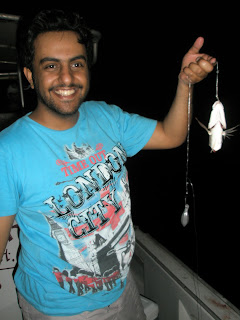We chartered a small boat complete with a driver, bait, net, fishing line, and non-alcoholic drinks.

First stop was about 4 km from the shore, a floating Coast Guard station where you had to report who the occupants were and how long you would be. No I didn't take any pictures of the Coast Guard station, you learn quickly in the Middle East not take pictures of any kind of police/military/security installation.
We went out a few more kilometers and then dropped a long net, which we were going to pick up our way back.

After another couple of kilometers we stopped for fishing. I'm not up on my fishing terminology but I will describe what we did as "free-line" fishing. No rod or reel was involved. You had a fishing line with two or three hooks and a weight, baited the hooks (we used squid that the boat assistant helpfully chopped up for us), then you let the line sink into the water to the seabed and hold onto it with your hands ready to yank up when a fish bit the hook. While some of us used gloves we would only use them on one hand, you needed one hand ungloved to feel the slight tugging when the fish was nibbling the bait. The Gulf is a fairly shallow body of water, even 10 km out I figure the water was only about 35 to 40 feet deep.
These guys knew what they were doing -- we caught fish right away. Within 10 minutes we had a few fish, and while I was not as successful as the others it maybe took all of 20 minutes for me:

We were mostly catching a fish called Sherry (sp?). They are not particularly big fish like salmon but then again there's no way you could catch big fish using your bare hands on a fishing line! I didn't care, I was just glad to catch one. It's usually embarrassing when everybody else can catch fish but not you.
Soon the fish were building up in the boat but after a while they weren’t biting so we moved to some other spots to collect more. Occasionally we would catch something else like a small grouper or a small yellow fish called Nasr in Arabic. We kept pulling in more and more:

Most of the guys caught well over a dozen each, I caught six. My fish seemed to have a particular knack for eating my bait without biting the hook. More often than not I would feel nibbles, pull up the line, and see bare hooks with no bait on them! Not sure how they always did that. Ali was standing next to me and catching lots of fish so I started bugging him that he was stealing my fish.
One guy almost caught a barracuda! It was probably two and half feet long but as soon as he tried to haul it up into the boat the line snapped and it got away. I didn't manage to get a picture of it but I do have some wild proof that barracuda were definitely near the boat:

Yup, Ali caught a Sherry and while hauling it up a barracuda cut it in half! It had to be the most bizarre catch I've ever seen -- a half-fish.
After about four hours of fishing the sun went down and luckily for us in the darkness Mohammed spotted a large cargo ship bearing down on us, with almost no lights on it, so we maxed the engines to get away. We decided then to end the fishing and go back for the net. For some reason lugging up the net was a real effort. We soon discovered why:

The net had caught some steel fishing traps, three of them. We had to haul them all up to free our net before putting the traps back in the water. But the net had still caught a number of fish:

Including a parrotfish.
Mohammed, who fishes frequently in the Gulf, had never seen one caught here before. He decided to take it to his uncle who I guess knew more about fish in the Gulf.
After checking in with the Coast Guard we headed back and divided up the pretty full cooler of fish that we had. I only took about seven fish, what was I going to do with a bunch of fish? Thankfully I know some people with of a lot of pet cats who will hopefully use them.
All in all a great day was had. Free-line fishing in the Gulf was a great way to spend the day.



